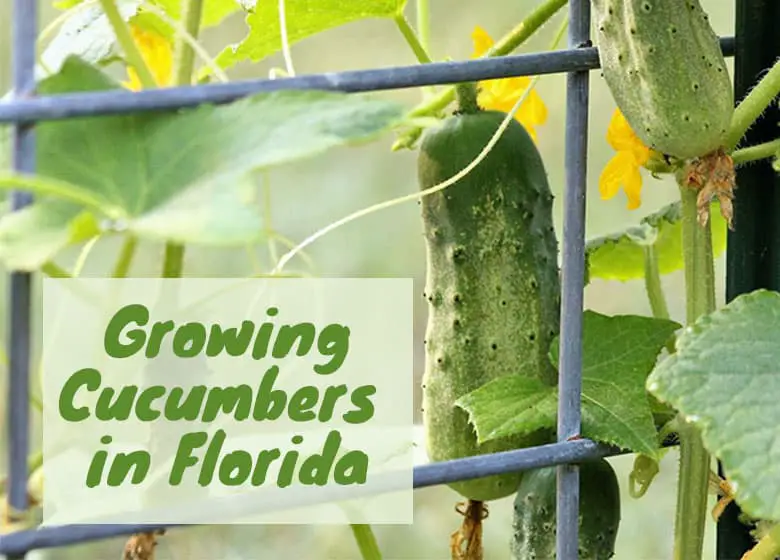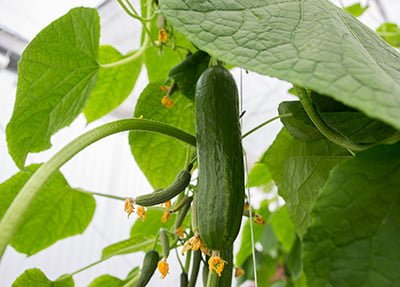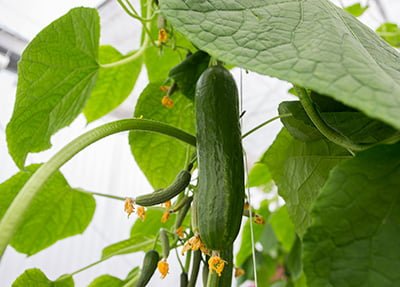Are you a passionate gardener in Central Florida longing to grow your own cucumbers? Well, you’re in luck! In this article, we’ll reveal the best time to plant cucumbers in your region, ensuring a thriving harvest that will leave your taste buds satisfied. Whether you’re a seasoned horticulturist or a green-thumb enthusiast, this invaluable information will guide you towards optimum planting success. Say goodbye to store-bought cucumbers and hello to a bountiful crop right in your own backyard.

Factors to Consider
When deciding when to plant cucumbers in Central Florida, there are several factors to consider. These factors include temperature, rainfall, and sunlight. Each of these factors plays a crucial role in the success of cucumber plants and can greatly impact their growth and yield.
Temperature Requirements
Cucumbers are warm-season vegetables that thrive in moderate to warm temperatures. Understanding the temperature requirements will help you determine the optimal planting time for your cucumber plants.
Ideal Temperature Range
The ideal temperature range for cucumber plants in Central Florida is between 70 and 90 degrees Fahrenheit. Cucumbers prefer daytime temperatures around 80 degrees Fahrenheit, while nighttime temperatures should not fall below 60 degrees Fahrenheit. Planting cucumbers when the temperature remains within this range will provide the best growing conditions.
Minimum Temperature
Cucumber plants are sensitive to cold temperatures and can be easily damaged or killed by frost. The minimum temperature for successfully growing cucumbers in Central Florida is 55 degrees Fahrenheit. Planting cucumbers too early in the season when the possibility of frost still exists can result in stunted growth or even plant death.
Maximum Temperature
While cucumbers thrive in warm temperatures, excessive heat can also affect their growth and production. When the temperatures consistently reach above 95 degrees Fahrenheit, cucumbers may experience reduced fruit set and poor fruit quality. Providing shade and proper watering during periods of extreme heat can help mitigate any adverse effects.
Rainfall Considerations
Rainfall is another essential factor to consider when deciding when to plant cucumbers in Central Florida. Adequate and consistent moisture is crucial for the healthy growth and development of cucumber plants.
Amount of Rainfall
Cucumber plants require regular water to thrive. The average rainfall in Central Florida varies, but it is essential to ensure that the plants receive at least one inch of water per week, either through rainfall or supplemental irrigation. If the rainfall is insufficient, proper watering techniques need to be implemented to maintain consistent moisture levels.
Watering Requirements
When rainfall is not sufficient, it is crucial to water cucumbers deeply and thoroughly. Watering in the morning is recommended to allow the foliage to dry out during the day, reducing the risk of foliar diseases. Additionally, mulching around the base of the plants can help retain soil moisture and reduce water evaporation.
Sunlight Needs
Sunlight is crucial for the growth and development of cucumber plants. Understanding the sunlight requirements will help you provide the optimal growing conditions for your cucumber plants.
Sunlight Duration
Cucumbers require full sun exposure for at least 6 to 8 hours a day. Select a planting location in your garden that receives maximum sunlight to ensure healthy plant growth. Insufficient sunlight can result in sparse foliage, reduced flower formation, and subsequently, lower fruit production.
Shade Tolerance
While cucumbers prefer full sun, they can tolerate some shade. However, prolonged periods of shade can adversely affect their growth and yield. If your planting location has partial shade, ensure that the cucumbers receive adequate sunlight during the peak hours of the day to promote healthy growth.
Cucumber Varieties for Central Florida
Choosing the right cucumber varieties is essential for successful cultivation in Central Florida’s unique growing conditions. Certain varieties are better suited to withstand the region’s high temperatures and humidity.
Recommended Varieties
When planting cucumbers in Central Florida, it is advisable to choose disease-resistant varieties that can withstand the region’s typical challenges. Some recommended cucumber varieties for Central Florida include:
- Marketmore 76: A popular variety known for its disease resistance and ability to produce long, straight fruits.
- Ashley: A versatile variety that adapts well to Central Florida’s climate, producing medium-sized, smooth-skinned cucumbers.
- Diva: A popular variety known for its resistance to common cucumber diseases and the ability to produce high-quality fruits over an extended period.
Heat-Tolerant Varieties
Central Florida’s hot and humid climate can be challenging for cucumber plants. Consider selecting heat-tolerant cucumber varieties to ensure successful growth. Some heat-tolerant cucumber varieties suitable for Central Florida include:
- Suyo Long: A long and slender variety, well-adapted to hot climates. It produces crisp, sweet cucumbers and excels in heat tolerance.
- Lemon Cucumber: This unique variety produces round, yellow fruits with a flavor similar to a cucumber and lemon hybrid. It is known for its heat tolerance and refreshing taste.
- Armenian Cucumber: Though technically a melon, this cucumber-like fruit thrives in hot climates. It grows long and slender, with a mild, refreshing flavor.

Planting Seasons
Choosing the right planting season is vital to ensure the successful establishment and growth of cucumber plants in Central Florida. The region’s climate allows for year-round cultivation, but certain seasons are more favorable than others.
Spring Season
Spring is an excellent time to plant cucumbers in Central Florida. As the temperatures warm up, cucumber plants benefit from the increasing heat and longer daylight hours. Starting cucumber plants indoors and transplanting them into the garden after the last frost date is a common practice during the spring season.
Fall Season
The fall season also offers favorable conditions for growing cucumbers in Central Florida. Planting cucumbers in late summer or early fall allows them to mature before the arrival of colder temperatures. Fall-planted cucumber plants also benefit from decreased pest pressure and more consistent moisture levels compared to the summer months.
Winter Season
Central Florida’s mild winters make it possible to grow cucumbers even during the winter months. However, it is essential to select cold-tolerant varieties and provide ample protection if frost or prolonged cold spells are expected. Utilizing season extension techniques like row covers can help protect plants and extend the growing season.
Preparing the Soil
Preparing the soil is a crucial step in successfully growing cucumbers. Proper soil preparation ensures that the plants have access to essential nutrients and a favorable growing environment.
Soil Testing
Before planting cucumbers, it is recommended to conduct a soil test to determine its composition and nutrient levels. Soil testing provides valuable information about pH levels, organic matter content, and presence of any nutrient deficiencies. Based on the test results, necessary amendments can be added to optimize the soil quality.
Soil Amendments
Adding organic matter, such as compost or well-rotted manure, is beneficial for improving soil structure and fertility. Organic matter enhances the soil’s ability to hold moisture, improves drainage, and provides essential nutrients for plant growth. Incorporating amendments like compost or aged manure into the soil before planting cucumbers can greatly enhance their health and productivity.
pH Levels
Cucumbers prefer a slightly acidic to neutral soil pH between 6.0 and 7.0. Conducting a soil test will provide a precise pH reading, and accordingly, you can adjust the pH level by adding amendments like lime to raise it or sulfur to lower it. Maintaining the appropriate pH level ensures that the soil’s nutrient availability is optimal for cucumber plants.

Planting Techniques
Cucumbers can be planted either by direct seeding or by transplanting seedlings. Each technique has its own advantages, and the choice depends on personal preference and specific circumstances.
Direct Seeding
Direct seeding involves planting cucumber seeds directly into the garden soil. This technique is simple and cost-effective. Ensure that the soil has warmed up sufficiently to promote germination and establishment of the seedlings. Sow the seeds at the recommended depth, typically around half an inch, and provide adequate moisture. Direct seeding is a popular choice for gardeners looking for a straightforward planting method.
Transplanting
Transplanting involves starting cucumber seeds indoors or in a greenhouse and then transplanting the seedlings into the garden once they have developed a few true leaves. This technique provides the advantage of an extended growing season and allows for better control over environmental conditions. Transplanting cucumber seedlings can be done after the danger of frost has passed, typically when temperatures are consistently above 55 degrees Fahrenheit.
Proper Spacing
Providing proper spacing between cucumber plants is crucial for their healthy growth, optimum air circulation, and disease prevention.
Spacing Between Plants
Cucumber plants require adequate space to spread their vines and produce high-quality fruits. Space the plants approximately 24 to 36 inches apart in rows. This spacing ensures that each plant receives ample sunlight, allows for proper air circulation, and reduces the risk of disease development.
Spacing Between Rows
Leaving sufficient space between rows is essential for ease of access, efficient watering, and proper maintenance of the cucumber plants. Rows should be spaced approximately 4 to 6 feet apart to allow room for vines to grow and for gardeners to navigate between them comfortably.

Pest and Disease Management
Like any other plants, cucumbers are susceptible to pests and diseases. Implementing proper pest and disease management practices can help protect the plants and ensure a successful harvest.
Common Pests
Some common pests that can affect cucumber plants in Central Florida include cucumber beetles, aphids, spider mites, and squash bugs. Regular inspection and monitoring of the plants are crucial to identify any pest infestations early. Utilizing organic pest control methods like handpicking, sticky traps, or introducing beneficial insects can help manage pest populations without the use of harmful chemicals.
Prevention and Treatment
Prevention is key in managing pests and diseases in cucumber plants. Implementing good cultural practices like removing garden debris, practicing crop rotation, and ensuring adequate air circulation can help prevent the spread of diseases. Additionally, maintaining proper watering techniques and avoiding over-fertilization can contribute to plant health. If necessary, organic-approved treatments like neem oil or insecticidal soaps can be used to control pests or diseases.
In conclusion, determining the best time to plant cucumbers in Central Florida involves considering various factors such as temperature, rainfall, and sunlight requirements. It is important to select suitable cucumber varieties, prepare the soil adequately, and implement proper planting techniques. Understanding the region’s specific climatic conditions and employing effective pest and disease management strategies will help ensure a successful cucumber harvest. With proper planning and care, growing cucumbers in Central Florida can be a rewarding and enjoyable experience.



